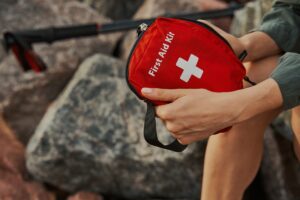
Beaches across America are posting signs stating “swim at your own risk,” due to a lifeguard shortage. From Maine to Colorado, it’s getting harder to find qualified lifeguards. Additionally, there are not enough applicants.
“There are likely between 30,000 and 50,000 lifeguards at beaches in the U.S. and more are needed,” said Tom Gill, a spokesman for the United States Lifesaving Association.
Why the shortage of Lifeguards?
Some believe that the job began losing appeal much like the Tv show “Baywatch” did. In 2001, this show stopped airing. Around the same time, many potential lifeguards were born. Being unable to bring your cell phone up to the chair is another thing that deters people from the job. This shortage is pushing current lifeguards to their limits. Most beach lifeguards have to work longer shifts to fill the void. Yet beachgoers are still not guaranteed safety.
At Reid State Park in Georgetown, Maine, 19-year-old lifeguard Kyle Hummel said the lack of lifeguards can sometimes make this rewarding job stressful.
“More eyes mean more safety,” Hummel says. “You’re totally responsible for everything that happens.”
Along the beaches, tall lifeguard chairs are spaced out evenly. However, some chairs in the line stand vacant. This causes blind spots and means it can take longer to respond to some emergencies.
Not Enough Qualified Applicants
The lifeguard shortage is leaving public service workers baffled. Lifeguarding is considered a high-paying seasonal job for high school students. The national pay average is $12.75 per hour and states such as Maine pay $15.02 per hour. In neighbouring New Hampshire, the small town of Hampton is home to Plaice Cove, which is the most popular beach in the state. Lifeguarding here was previously considered a prestigious summer job. However, in 2016, only two people applied and five positions needed to be filled.
In 1999 and 2000, beaches saw similar shortages. This was blamed on the demanding training that the job requires. During the 2008 Recession, job prospects were minimal for high school and university students. This allowed for many lifeguards to get trained fairly quickly. However, after the economy started to recover, this changed pretty quickly. More young people opted to work in the service industry where less training is needed.
What’s needed to become a lifeguard?
As mentioned earlier, part of the lifeguard shortage is the amount of training required. However, the process is not as long as some may think. All lifeguards must be certified in CPR, First Aid and AED certifications. These can be obtained at many places including the American Red Cross, the American Association of Lifeguards and AquaMobile. Each of these plays an important role in keeping patrons safe at the beach. So there is a good reason why employees have to undergo these training processes.
Learn to Swim Before Hitting the Beach
A 2014 American Red Cross survey found that 80% of Americans think they can swim. However, a mere 56% could save their own lives if they had to. The study was part of the Red Cross’s effort to cut the drowning rate by 50% in 50 cities over the next three to five years. This campaign is coming at a critical time. An average of 10 people per day die from unintentional drowning in the U.S. alone. What’s even scarier is 32% of Americans plan to swim at a place without a lifeguard this summer.
If you feel you or your child lack water safety skills, we are here to help! If you are interested in starting a fun and fulfilling career, why not check out our lifeguard training courses?



